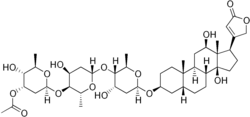α-Acetyldigoxin
 | |
| Clinical data | |
|---|---|
| AHFS/Drugs.com | International Drug Names |
| Routes of administration | Oral |
| ATC code | |
| Pharmacokinetic data | |
| Bioavailability | 90%(Oral) |
| Protein binding | 20–30% |
| Elimination half-life | 40h |
| Identifiers | |
| |
| CAS Number | |
| PubChem CID | |
| ChemSpider | |
| UNII | |
| CompTox Dashboard (EPA) | |
| ECHA InfoCard | 100.024.414 |
| Chemical and physical data | |
| Formula | C43H66O15 |
| Molar mass | 822.986 g·mol−1 |
| 3D model (JSmol) | |
| |
| |
| (verify) | |
α-Acetyldigoxin is a cardiac glycoside found in plants of the genus Digitalis, including Digitalis lanata.[1] It is an acetyl derivative of digoxin and an isomer of β-acetyldigoxin.
α-Acetyldigoxin increases the contractility of the heart by its positive inotropic effect on cardiac muscle. The effects of α-acetyldigoxin begin 3–4 hours after administration, and maximize after 6–8 hours. It is prescribed for congestive chronic cardiac failure class II, III and IV.
References
- ^ Gisvold O (August 1972). "Acetyldigoxin and acetyldigitoxin from digitalis lanata". Journal of Pharmaceutical Sciences. 61 (8): 1320–1321. doi:10.1002/jps.2600610835. PMID 5050388.